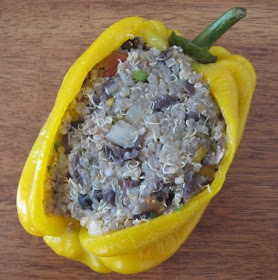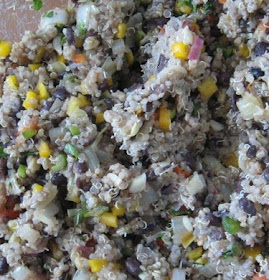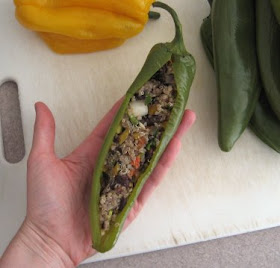At the farmer's market seconds bin, 60 cents a pound:

Are those Anaheims? Hatch? Who cares? We stuffed a bag full and ran home to make a gigantic stash of freezer food.
This process is kind of a pain in the neck, but it isn't hard--just tedious. It's definitely worth the effort to make a big batch, though, which will become evident a few months in the future, when you walk home from the train one day through a snowstorm.
 Black bean quinoa stuffed peppers
Black bean quinoa stuffed peppers
cooked black beans
quinoa
onion/garlic
olive oil
hot peppers
sweet peppers
stuffable peppers
optional veg: corn, green onion, etc.
salt, black pepper, cumin, paprika, oregano
This has three main steps. First, make a black bean-quinoa melange with which to stuff the peppers. Next, steam peppers, gut them, and stuff them. Last, freeze them (or, if you want to eat them now, bake them).
Melange: if you're starting from dried beans, soak them overnight, change the water, and simmer with a bay leaf until tender. Two or three big handfuls of dry beans should be plenty. Drain off the boiling liquid (put it in the freezer for instant black bean stock) and you're ready to go. You can definitely do this in advance. You can also use canned beans if that's how you roll. Kidney, white, or garbonzo beans will work as well.
Put a pan of quinoa on to cook. The amount depends on how many peppers you want to stuff, but unless you're trying to completely fill your freezer, one cup is plenty. You can cook quinoa like any grain: add double its volume in water and simmer, covered, until cooked. I use the rice cooker. If you don't want quinoa, any other grain should work fine.
While the grain is cooking, warm a wide saute pan. Chop up an onion and a handful of garlic cloves; soften them in olive oil. Mince a hot pepper or two, and dice a few sweet peppers that are in no shape to stuff. Add them to the pan to soften as well. You may also want to add some spices, like cumin, paprika, or a little oregano, though the hot pepper and garlic are already fairly strong. Spice it so it tastes good to you.
If you want to add any other vegetables, now is the time to do it, as long as they aren't greens. Corn is great--either cut it right off the cob, or defrost frozen kernels in hot water. Other good additions: roasted winter squash, sweet potato, tomato, nopales--whatever. Add your vegetables to the pan and let cook a few minutes to soften before you add your black beans.

At the same time, bring a pot of water to boil. Wash your stuffable peppers--long Anaheims or larger bell peppers will both work well here--and put them in a steamer basket that fits the pan. Don't crowd them; you want to make sure the steam will hit them all, so you may want to do this in batches. When the water boils, steam your peppers for about three to five minutes, then take them off the heat and let them cool.
By this time both your grain and your bean mixture should be done. Mix the two together, either in the pan (off the heat) or in a large bowl. If you want to add any softer greens, such as chopped spinach or chard, green onion tops, or parsley, this is the time to do so. Salt, pepper, and mix well.

Now it's time to stuff. First, cut a long slit down the side of a pepper. Flex it gently to make an opening, and reach through to pull out and discard the seeds and any attached membranes. This doesn't have to be absolutely perfect; just get the majority out. Then stuff the pepper with the bean and grain mix, using a spoon to gradually pack all the crevices full. The slit doesn't have to re-close when you're done, so use plenty of filling.
Your peppers may occasionally rip a bit; if so, be especially careful to hold the ripped part stable while you're stuffing. However, it's not really that big of a deal: your peppers will be delicious anyway. Repeat until you're out of either peppers or filling. I made ten peppers.

I personally had lots of filling left over, so I ended up eating quinoa-black bean tacos for dinner and freezing every single stuffed pepper. To freeze: wrap each pepper in foil and put them in the freezer. Tres facile and tres vogue. You can also put all your peppers on a baking sheet, freeze them like that, and put the frozen pieces into one bag later. Use whichever method fits best in your freezer.
When you're ready to eat some peppers, just take off the foil, put them on a baking sheet, and bake at 350F until hot through and beginning to brown. You could always add some olive oiled and begarlicked breadcrumbs to the tops, but these are just as delicious baked plain. Besides, who wants to mess up the rest of the kitchen?